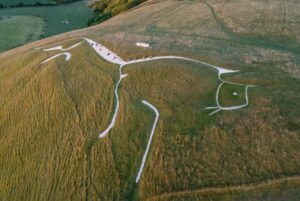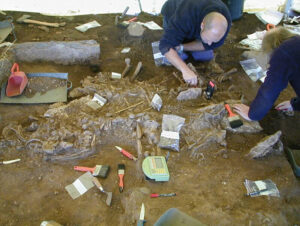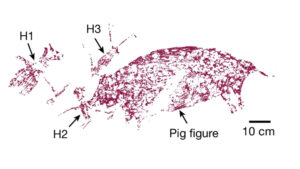“Then the Lord said to Noah: Go into the ark you and all your household…For seven days from now, I will bring rain down on the earth for 40 days and 40 nights, and so I will wipe out from the face of the earth every being that I have made.”
We have all heard this Bible story.
Before punishing Earth with a great deluge, God told Noah to build an ark in which he, his family, and animals would find refuge. Interestingly enough, the flood narrative is not unique to the Old Testament. Over 200 cultures contain stories and texts about a great flood that wiped out humanity. How did this cross-cultural phenomenon come to be? Did a worldwide flood actually happen?
What is the Flood Myth?
The most notable mythologies that include the flood narrative are the Old Testament, the Epic of Gilgamesh, Plato’s Timaeus, the Satapatha Brahmana, and Mesoamerican creation stories. In the Epic of Gilgamesh, an ancient Mesopotamian epic poem written on a clay tablet, the Sumerian deities Anu, Enlil, Ninurta, Ennugi, and Ea decide to send a flood to wipe out the earth. However, Ea sympathizes with humans and informs a man named Utnapishti to build a boat/ark to save himself and his wife.

The Deluge (exhibited 1840). Painting: Francis Danby 1793-1861
The text reads: “O man of Shurrupak, son of Ubara-Tutu; tear down your house and build a boat…For six days and six nights, the winds blew, torrent and tempest and flood overwhelmed the world…”
After the waters subsided, Utnapishtim and his wife received immortality as a reward for their obedience.
In Greek myth, Deucalion — the son of the Titan Prometheus — survives the great flood inflicted by Zeus. The Olympian god had grown weary of humanity’s pride and greed. Like the other stories, Deucalion finds refuge in a chest with his wife Pyrrha. When the waters receded after nine days, it left their boat perched on a mountaintop.
In Hindu mythology, a man named Manu receives word from a fish that a great calamity is imminent. He builds a boat and survives, likewise finding refuge on a mountaintop. He performs a sacrifice in thanks. And we shouldn’t forget the myth of Atlantis, which Plato used to highlight the consequences of human greed.
The creation stories of the Aztecs, Maya, and Totonac all speak of floods bringing in a new age for mankind.
Details all the same
The list goes on, and the details are essentially the same. All have similar characteristics. Humans have displeased the gods, and the gods send a great flood as punishment. Every story has a “culture hero” whom the gods decide to spare. From this individual, the world repopulates.
Most scholars argue that the flood myth is simply an allegory for what happens when humans are sinful and indulgent. It is also a symbolic tale of rebirth and cleansing. However, there are those who believe that the flood really did happen.

Gilgamesh as Master of Animals, grasping a lion in his left arm and a snake in his right hand. Photo: Dima Moroz/Shutterstock
First theory
As of now, two main hypotheses take the lead. Firstly, environmental archaeologist Bruce Masse with the Los Alamos National Laboratory champions the theory that an asteroid struck the earth in the Indian Ocean. This created sudden mega-tsunamis. This asteroid would have been 4.8km wide and the waves almost 200m high.
Masse also believes that such a cataclysm would have generated devastating storms and winds. He believes that the event occurred around 3000 BC and cites the Burckle and Fenambosy Chevron craters as evidence.
Second theory
The second theory, called the Black Sea Deluge, is supported by marine scientists William Ryan, Walter Pitman, and several others in the 1990s. According to them, the Mediterranean Sea flowed into the Black Sea, thereby mixing fresh and salt water. This supposedly took place 7,600 years ago. Sea levels rose from melting ice sheets and glaciers until the Mediterranean pushed through an area called the Bosporus Strait and flooded into the Black Sea.
Underwater archaeologists have analyzed sediment layers beneath the surface. They found remnants of plants, small invertebrates, and the ruins of houses and artifacts. These materials date back around 7600 years. The effect would have been catastrophic for the people who lived on the Black Sea coastline. However, this is one isolated area and not the whole world.

Coast of the Black Sea. Photo: Kalina Georgieva/Shutterstock
Excavations took place at the ancient Sumerian city of Shuruppak in the 1930s which initially supported the flood myth. Archaeologists believed that they found a flood layer between sand and silt. One scholar, David MacDonald, stated, “Within a few months of one another during the 1928-1929 excavation season, archaeologists at two southern Mesopotamian sites, Ur and Kish, announced the discovery of flood deposits which they identified with the Flood described in the Hebrew scriptures and cuneiform sources.”
However, recent investigations found that the deposits might simply reflect a different kind of river phenomenon, not a large flood.
Conclusion
It is unlikely that the story passed between cultures simply through interactions. An event must have backed it up. Sea levels did rise after the last Ice Age because of the rapid melting of ice sheets and glaciers. Copious amounts of water would have encroached inland, devastating settlements and displacing local populations. While the flood probably was not as sudden and dramatic as the cultural stories would suggest, the meltwater hit different areas at different times. Low-lying lands flooded first, and higher lands later.
The trauma from this change in the landscape likely passed down through the generations, with each culture interpreting it in its own way. They all must have thought their gods were punishing them.






